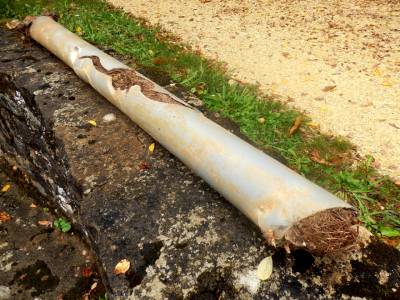 Here in the Pacific Northwest, we like to think of trees as our friends and neighbors. After all, like a dear friend, they’re always there for you, and they give great hugs. But did you know that the trees in your yard may be plotting against you? It’s true. Oh, they might look like they’re innocent, but deep down they want nothing more than to sneak into your pipes and turn your plumbing system into their drinking straw. BAD TREES, bad!
Here in the Pacific Northwest, we like to think of trees as our friends and neighbors. After all, like a dear friend, they’re always there for you, and they give great hugs. But did you know that the trees in your yard may be plotting against you? It’s true. Oh, they might look like they’re innocent, but deep down they want nothing more than to sneak into your pipes and turn your plumbing system into their drinking straw. BAD TREES, bad!
If you’ve never had tree roots invade your plumbing before, consider yourself lucky. It’s a surprisingly common problem – and it can lead to huge consequences if not addressed. So today, let’s talk about how tree roots can affect your sewer line.
The First Sign: Frequent Clogging
Here’s a common scenario that plays out all too often. A homeowner calls a plumber for a clog. The plumber comes out and snakes or hydro jets the drain. After that, the basin drains much faster. The problem seemingly resolved, the plumber leaves. But the problem wasn’t resolved – the tree roots are still there.
Sure, the basin is draining faster. This is likely because there was some gunk to be removed that had slowed the flow of water, but since the tree roots are still causing an obstruction further down the line, the clog will return much quicker than expected next time. Here are the early warning signs that there could be tree roots in your pipes:
- Recurring Clogs: If you clear clogs and they keep coming back, it could be a sign there are tree roots somewhere in your pipes obstructing water flow.
- Gurgling Sounds: Gurgling is caused by trapped air inside pipes. When the air bubble releases, it makes a sound. Think of it like your drain has indigestion and can’t stop belching.
- Unexpectedly High Water Bills: If your water bill suddenly goes way up, it might be because your utility company recently raised their rate. Check first to see if that’s the case, and if it’s not, your best bet is you’re dealing with a leak somewhere that you can’t see. Leaks often lead to increased water usage and inflated utility bills.
- Unpleasant Odors: When there are blockages in the pipes, things get stuck. They decay in your plumbing system. Those odors will eventually make their way back through the drains into your home. Yuck.
- Reduced Water Pressure: Gauge your water pressure at fixtures throughout your home – sinks, showers, and toilets. If it seems less forceful, that’s a strong sign that there’s a clog or leak in your plumbing.
- Rapid Tree Growth: If a tree in your yard is growing suspiciously fast, like that one player on your kid’s little league team with a mustache who looks like he’s about to turn 25, it’s a sign that it’s getting overwatered by your plumbing.
How Do Tree Roots Get Into My Pipes in the First Place?
Now, you might be saying to yourself, “my trees would never betray me,” but the truth is tree roots don’t listen to anybody. The only thing they care about is getting more water and nutrients to support the tree. Young roots are tiny, wispy tendrils and can wriggle into almost any space. In pipe sections with joined pipes or gaskets, there’s plenty of room.
Once inside the pipe, the tree gets as much water as it wants. The root grows thicker and stronger. Clogs start happening. It grows too big for the pipe. This is when the risk of serious plumbing issues becomes a concern. It’s estimated that one tree root has a tensile strength of anywhere from 10 to about 60 megapascals. That’s incredibly strong. To put it in perspective, an item stuck in cement has a tensile strength of about 10 to 30 MPa.
What Does Long-Term Tree Root Damage to My Plumbing Look Like?
It might not take long for a small tree root problem to grow into a large one. Here are some of the major problems tree roots in your plumbing can cause to your property:
- Foundation Cracks: Tree roots are powerful. If they grow large and apply constant pressure on your pipes, this can very easily lead to cracks in the foundation of your home.
- Soggy or Flooded Yard: Tree roots can crack underground pipes, releasing water and sewage into the ground. You’ll notice this in the form of an overly saturated yard.
- Muddy or Discolored Water: In certain instances, blockages caused by tree roots can cause discolored water to come through the faucets.
- Sinkholes: Just like a soggy or flooded yard, but worse. If a large enough volume of water is leaking underground, it can lead to sinkholes in your yard.
Early Detection Is Key
Trees: with friends like that, who needs enemies? But before you go out into your yard and scold your trees for their conspiratorial ways, it’s important to understand that this is an easy problem to solve – as long as you catch it early. Because the early warning signs mimic minor plumbing problems, most homeowners do not realize tree roots are a problem – or even that they can be a problem – until there’s a complete blockage or even flooding.
That’s why, if you’re experiencing recurring blockages in your plumbing, gurgling sounds, reduced water pressure, or any of the other early warning signs, call D&F to come take a look.
The boys in plaid are trained to detect leaks quickly and easily no matter where they are in your plumbing system – even in pipes buried underground. They come equipped with cutting-edge camera imaging technology to give you a full picture of the situation.
Sewer-Safe Landscaping Tips
Of course, if you’re landscaping a new property, there are some things you can do to prevent tree roots from becoming a problem. For example, planting trees a safe distance from existing pipes makes a huge difference. Your plumber can tell you where your sewer line is located.
There are also certain species of trees with less potential to damage pipes. Believe it or not, sewer-friendly trees are a thing. These trees have roots that don’t travel as wide or deep, so if you plant them away from your lines they shouldn’t cause problems.
Call Today to Find Out
If you’re dealing with mysterious plumbing problems that don’t seem to go away, the problem might be tree roots in your plumbing. If this is a possibility, we recommend acting quickly because it’s likely the problem will only get worse, and can lead to a full sewer line repair, which is a much more expensive and intensive job.
Don’t let your tree friendships wither – leaf it to the plaid-clad pros at D&F and call us today.



